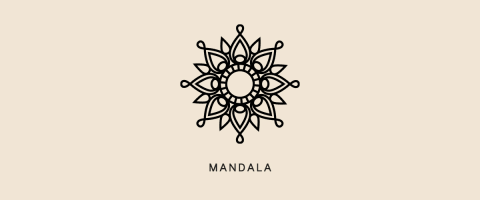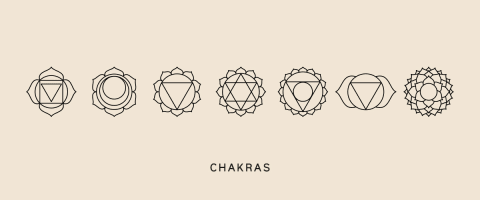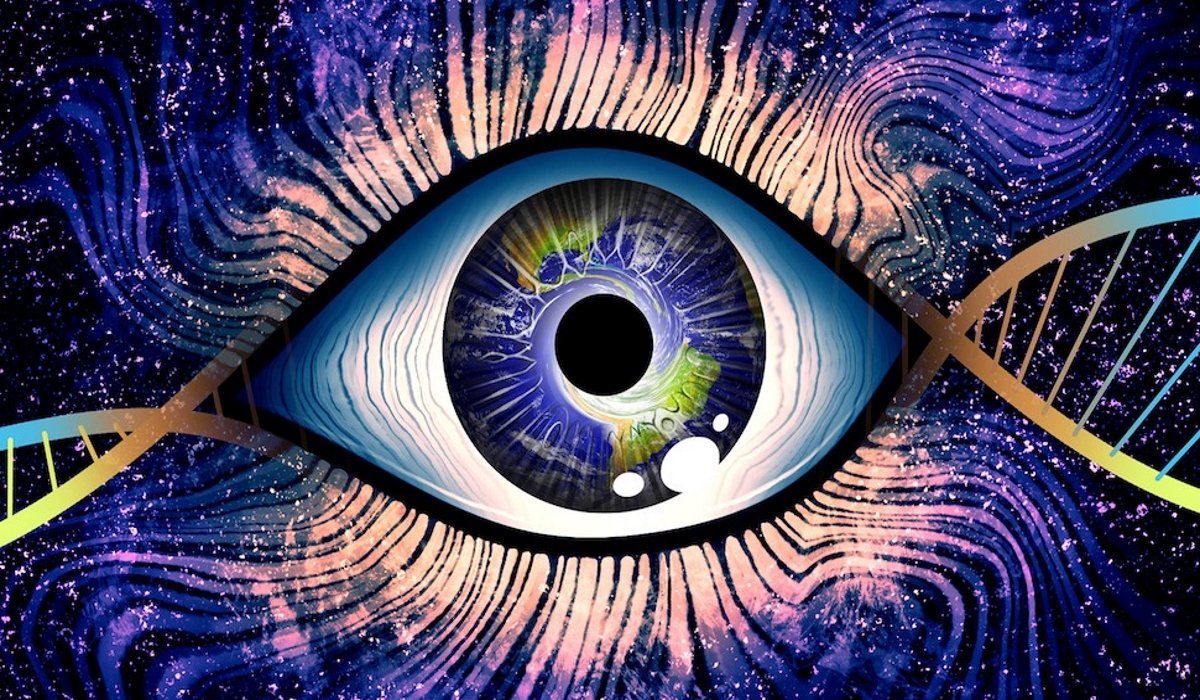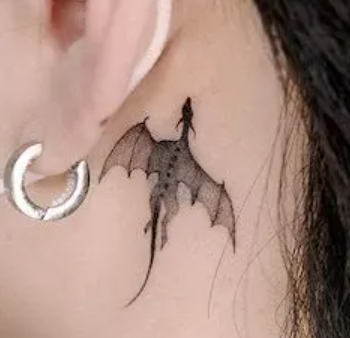Meaning & History Behind 9 Common Spiritual Symbols, Plus How To Use Them
If you’re beginning to dip your toes into a yoga practice, study eastern religion, or learn more about spirituality, you may have noticed a few symbols pop up again and again: the Om symbol, a chakra chart, a lotus flower. So, what do they all represent? Here’s an overview of the meanings and history of some of the most common spiritual symbols to help you integrate them into your own practice meaningfully and respectfully:
Om

The Om symbol comes from Hinduism. “Yoga is all about unification, and the Om symbol represents that in Hinduism,” Dheepa Sundaram, Ph.D., assistant professor of religious studies at the University of Denver, tells mbg. The symbol was included in the Vedas, the most ancient Hindu Scriptures, and it refers to the breath of the universe, thought to be its original sound.
The various curves of this symbol represent waking consciousness, dreaming, and deep sleep. The small curved line in the middle represents illusion, and it separates one from transcendence, which is represented by the topmost shape.
How to use it:
Chant “Om” while thinking of your connection to the universe.
Lotus flower

Another Hindu symbol, the lotus flower, represents “the womb of the universe from which all things are born,” Sundaram tells mbg. Even today, the lotus flower is the national flower of India, though it’s been a part of Hindu culture for centuries.
“Lotuses only grow in really swampy areas, so that symbolizes this idea that out of ugliness and destruction and unrest, we can all come together in this perfect moment and we’re all connected,” she says. “And in that respect it also has an indirect relation to the Buddhist idea of the universal soul.”
How to use it:
Practice lotus pose, or “padmasana,” in which you sit cross-legged with one foot resting on top of the other thigh. Then, slowly pull your heel toward the top of your inner thigh and repeat with the other leg.
Hamsa

The hamsa is connected to a number of traditions. Today, it is a popular symbol for warding off evil and negativity and it’s often found on jewelry and clothing. Sundaram notes it has links to Islam, Judaism, Hinduism, and Buddhism.
“Within Islam and Judaism, it’s about warding off the evil eye—the idea of the protector,” she says. “In Hinduism it’s often used as a synonym for the supreme spirit or the ultimate reality, which is called ‘Brahman,’ as well as a vehicle for knowledge. In Buddhism it represents the universal spirit and being released from the cycle of rebirth, or samsara.”
How to use it:
Wear it or display it in your space for protection.

Siddhartha Gautama, who would become known as the Buddha, lived during the fifth century B.C., and since Buddhism has grown, his image has been used to represent enlightenment, oneness, and peace. Buddhism as a religion comes back to the teachings of the Buddha, and Buddha statues are common around the world in spiritual spaces. Sometimes depicted as Zen, sometimes laughing, the Buddha himself can be thought of as one of the original yogis and a teacher that dispels ignorance, Sundaram says.
How to use it:
Study the teachings of Buddha and refer to the statue as a symbol of what the Buddha and Buddhism represent.
Mandala

Mandalas have been traditionally linked with Buddhism and Hinduism. These intricate designs represent the world as well as the journey of the self. Their many layers illustrate the qualities needed to attain wisdom and reach enlightenment.
Buddhist monks use mandalas made of sand to symbolize impermanence and the need to go beyond the material. “In Buddhist traditions, it specifically represents impermanence,” she says. “In Hindu traditions, it shows the connection and trajectory between the material and the immaterial.”
How to use it:
Draw your own mandala as a type of moving meditation.
Evil eye

The evil eye is related to the hamsa, and it’s a pervasive theme in Judaism, Islam, Hinduism, Buddhism, and even ancient Greek and Roman cultures. “The idea is that the evil eye is somebody putting too much emphasis on you,” explains Sundaram. “They’re paying too much attention to you.” The symbol dates back to sixth century B.C., and today it is often worn or displayed as a talisman to ward off any ill will from people.
How to use it:
Hang an evil eye in your doorway to protect your home from outside negativity.
The chakras

Like Om, the chakras were first mentioned in the Vedas. We have lots of chakras in our body, but the main seven chakras run up our spine, starting at the base and reaching the top of the head. We can think of them as “our invisible body,” Sundaram says: “I imagine them as a spiritual circulatory system with energy centers in various parts.”
When any of them are blocked or stagnant, it can cause various disruptions to our well-being (depending on which chakra is imbalanced).
How to use it:
Depending on what chakra you feel is out of whack, try a chakra meditation to restore balance.
Namaste

Many yoga teachers will end their class by saying some variation of “The light in me honors the light in you—namaste.” It’s a lovely sentiment; however, Sundaram notes this phrase has become a bit overused and misconstrued. It does mean “I honor you,” she explains, but in India, it’s simply an equivalent to “hello” or “welcome.”
“No one should not use namaste,” she adds, “but we shouldn’t impart meaning to it that doesn’t exist because that’s when we start to exoticize cultures we don’t understand.”
How to use it:
Choose your words carefully and consider sharing a different phrase if you find yourself using namaste often.
Yin & yang

Yin and yang represents masculine and feminine, light and dark, and the law of polarity. It’s been around since before the third century B.C. in China, and the idea of opposing forces has echoed in many cultures and schools of thought since. Ultimately, yin and yang demonstrate balance and the inherent harmony of nature.
How to use it:
Try out yin yoga as a relaxing alternative to more demanding flows.
Learning the history and meanings behind these common symbols can help deepen your spiritual practice when done with respect. “Oftentimes what we see is an eclectic display of Asian paraphernalia,” Sundaram adds, “and the history of the symbols does kind of get erased”—so be sure to understand the meaning behind what you’re doing.
There’s nothing wrong with wanting to embrace practices or symbols that resonate with you and speak to your own spiritual journey. The most important thing is to always practice with respect, and truly understand what it is you’re hanging up on your wall or saying after yoga class.
https://www.mindbodygreen.com/articles/common-yoga-symbols-and-how-to-use-them






